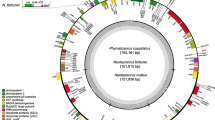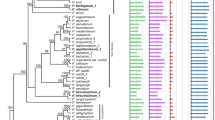Abstract
The molecular evolution of a chloroplast minisatellite locus in the Anacamptis palustris (Orchidaceae) lineage and haplotype variation in two Italian A. palustris populations were investigated. A phylogenetic analyses of the chloroplast tRNALEU intron, where the minisatellite locus is located, revealed that a deletion in the ancestor of the A. palustris lineage led to the formation of two noncontiguous, complementary sequence motifs. We propose a model to explain the initial formation of the minisatellite repeat motif, starting with the two noncontiguous, complementary sequence motifs. A survey of minisatellite variation in four species of the A. palustris lineage revealed several haplotypes that differed not only in repeat number, but also in repeat organization. A haplotype network suggests that three different minisatellite loci evolved independently at the same position in the tRNALEU intron. A secondary structure model revealed that the A. palustris minisatellite repeat forms a stem region of the tRNALEU intron, which allows its notable expansion without negatively affecting splicing. Minisatellite variation was high in the two examined A. palustris populations where 20 haplotypes were detected, whereas no length variation was detected in a neighboring poly (A) microsatellite locus. We estimated a chloroplast minisatellite mutation rate of 3.2 × 10−3 mutations per generation. Southern blot analyses did not find evidence for chloroplast heteroplasmy. Based on the analysis of the largest known, extant A. palustris population, a stepwise mutation model (SMM) was inferred.
Similar content being viewed by others
References
S Aceto S Cozzolino L Gaudio R Nazzaro P De Luca (1999a) ArticleTitlePollination flow between Orchis morio and O. papilionacea in hybrid formation in different habitats. Int J Plant Sci 160 1153–1156
S Aceto P Caputo S Cozzolino L Gaudio A Moretti (1999b) ArticleTitlePhylogeny and evolution of Orchis and allied genera based on ITS DNA variation: Morphological gaps and molecular continuity. Mol Phylogenet Evol 13 67–76 Occurrence Handle1:CAS:528:DyaK1MXmt1OmsLs%3D
CW Birky P Fuerst T Maruyama (1989) ArticleTitleOrganelle gene diversity under migration, mutation, and drift: Equilibrium expectations, approach to equilibrium, effects of heteroplasmic cells, and comparison to nuclear genes. Genetics 121 613–627 Occurrence Handle2714640
K Blasko SA Kaplan KG Higgins R Wolfson B Sears (1988) ArticleTitleVariation in copy number of a 24-base pair tandem repeat in the chloroplast DNA of Oenothera hookeri strain Johansen. Curr Genet 14 287–292 Occurrence Handle1:CAS:528:DyaL1cXmtVKisbk%3D Occurrence Handle3197136
D Cafasso G Pellegrino A Musacchio A Widmer S Cozzolino (2001) ArticleTitleCharacterization of a minisatellite repeat locus in the chloroplast genome of Orchis palustris (Orchidaceae). Curr Genet 39 394–398
JM Cornuet G Luikart (1996) ArticleTitleDescription and power analysis of two tests for detecting recent population bottlenecks from allele frequency data. Genetics 144 2001–2014 Occurrence Handle1:STN:280:ByiC3s3mtlU%3D Occurrence Handle8978083
S Cozzolino S Aceto P Caputo A Widmer A Dafni (2001) ArticleTitleSpeciation processes in Eastern Mediterranean Orchis s.1. species: Molecular evidence and the role of pollination biology. Isr J Plant Sci 49 91–103 Occurrence Handle10.1092/QV6M-E7A0-QFC7-G6BL Occurrence Handle1:CAS:528:DC%2BD3MXnsVKms7c%3D
P Delforge (1994) Guide des Orchidées d’Europe, d’Afrique du Nord et du Proche-Orient. Delachaux et Niestlé Lausanne
A Di Rienzo AC Peterson JC Garza AM Valdes M Slatkin NB Freimer (1994) ArticleTitleMutational processes of simple-sequence repeat loci in human populations. Proc Natl Acad Sci USA 91 3166–3170 Occurrence Handle8159720
JJ Doyle JL Doyle (1987) ArticleTitleA rapid DNA isolation procedure for small quantities of fresh leaf tissue. Phytochem Bull 19 11–15
H Ellegren (2000) ArticleTitleHeterogeneous mutation processes in human microsatellite DNA sequences. Nature Genet 24 400–402 Occurrence Handle10.1038/74249 Occurrence Handle1:CAS:528:DC%2BD3cXisVCjtr4%3D Occurrence Handle10742106
L Fumagalli P Taberlet L Favre J Hausser (1996) ArticleTitleOrigin and evolution of homologous repeated sequences in the mitochondrial DNA control region of shrews. Mol Biol Evol 13 IssueID1 31–46 Occurrence Handle1:CAS:528:DyaK28XhtVyltbk%3D Occurrence Handle8583904
T Giraud D Fortini C Levis Y Brygoo (1998) ArticleTitleThe minisatellite MSB1, in the fungus Botrytis cinerea, probably mutates by slippage. Mol Biol Evol 15 IssueID11 1524–1531 Occurrence Handle1:CAS:528:DyaK1cXntlOgs7o%3D
F Gugerli C Sperisen U Büchler F Magni T Geburek S Jeandroz J Senn (2001) ArticleTitleHaplotype variation in a mitochondrial tandem repeat of Norway spruce (Picea abies) populations suggests a serious founder effect during postglacial re-colonization of the western Alps. Mol Ecol 10 1255–1263 Occurrence Handle1:CAS:528:DC%2BD3MXktFKiuro%3D Occurrence Handle11380882
DG Higgins AJ Bleasby R Fuchs (1992) ArticleTitleCLUSTAL V: Improved software for multiple sequence alignment. Comput Appl Biosci 8 189–191 Occurrence Handle1591615
VD Hipkins KA Marshall DB Neale WH Rottmann SH Strauss (1995) ArticleTitleA mutation hotspot in the chloroplast genome of a conifer (Douglas-fir: Pseudotsuga) is caused by variability in the number of direct repeats derived from a partially duplicated tRNA gene. Curr Genet 27 572–579 Occurrence Handle1:CAS:528:DyaK2MXmslegtL8%3D Occurrence Handle7553944
K Isoda S Shiraishi H Kisanuki (2000) ArticleTitleClassifying Abies species (Pinaceae) based on the sequence variation of a tandemly repeated array found in the chloroplast DNA trnL and trnF intergenic spacer. Silvae Genet 49 IssueID3 161–l65
P Jarne PJL Lagoda (1996) ArticleTitleMicrosatellites, from molecules to populations and back. Trends Ecol Evol 11 IssueID10 424–429 Occurrence Handle10.1016/0169-5347(96)10049-5
AJ Jeffreys V Wilson SL Thein (1985) ArticleTitleHypervariable ‘minisatellite’ regions in human DNA. Nature 314 767–73
RA King C Ferris (2002) ArticleTitleA variable minisatellite sequence in the chloroplast genome of Sorbus L. (Rosaceae: Maloideae). Genome 45 570–576 Occurrence Handle10.1139/g02-018 Occurrence Handle1:CAS:528:DC%2BD38Xks1yju78%3D Occurrence Handle12033626
G Levinson GA Gutman (1987) ArticleTitleSlipped-strand mispairing: A major mechanism for DNA sequence evolution. Mol Biol Evol 4 IssueID3 203–221 Occurrence Handle1:CAS:528:DyaL2sXksFejsLw%3D Occurrence Handle3328815
DH Lunt LE Whipple BC Hyman (1998) ArticleTitleMitochondrial DNA variable number tandem repeat (VNTRs): Utility and problems in molecular ecology. Mol Ecol 7 1441–1455 Occurrence Handle10.1046/j.1365-294x.1998.00495.x Occurrence Handle1:CAS:528:DyaK1cXnsFSgt7g%3D Occurrence Handle9819900
M Nei (1987) Molecular evolutionary genetics. Columbia University Press New York
G Platas J Acero JA Borkowski V Gonzàlez MA Portal V Rubio J Sànchez-Ballesteros O Salazar F Pelàez (2001) ArticleTitlePresence of a simple tandem repeat in the ITS1 region of the Xylariales. Curr Microbiol 43 43–50 Occurrence Handle10.1007/s002840010258 Occurrence Handle1:CAS:528:DC%2BD3MXjslKgsLo%3D Occurrence Handle11375663
J Provan N Soranzo NJ Wilson DB Goldstein W Powell (1999) ArticleTitleA low mutation rate for chloroplast microsatellites. Genetics 153 943–947 Occurrence Handle1:CAS:528:DyaK1MXmvFGmsbc%3D Occurrence Handle10511569
DM Rand RG Harrison (1989) ArticleTitleMolecular population genetics of mtDNA size variation in crickets. Genetics 121 551–569 Occurrence Handle1:CAS:528:DyaL1MXhvVOjur4%3D Occurrence Handle2565855
GF Richard F Pâques (2000) ArticleTitleMini- and microsatellite expansions: the recombination connection. EMBO Rep 1 IssueID2 122–126 Occurrence Handle1:CAS:528:DC%2BD3cXnt1yrs7c%3D Occurrence Handle11265750
J Sambrook EF Fritsch T Maniatis (1989) Molecular cloning: A laboratory manual. Cold Spring Harbor Laboratory Press Cold Spring Harbor, NY
EA Sia RJ Kokoska M Dominska (1997) ArticleTitleMicrosatellite instability in yeast: Dependence on repeat unit size and DNA mismatch repair genes. Mol Cell Biol 17 IssueID5 2851–2858 Occurrence Handle1:CAS:528:DyaK2sXislCms78%3D Occurrence Handle9111357
M Soliva A Kocyan A Widmer (2001) ArticleTitleMolecular phylogenetics of the sexually deceptive orchid genus Ophrys (Orchidaceae) based on nuclear and chloroplast DNA sequences. Mol Phylogenet Evol 20 IssueID1 78–88 Occurrence Handle10.1006/mpev.2001.0953 Occurrence Handle1:CAS:528:DC%2BD3MXksF2mu70%3D Occurrence Handle11421649
DL Swofford (1998) Paup*. Phylogenetic analysis using parsimony (*and other methods). Version 4. Sinauer Associates Sunderland, MA
P Taberlet L Gielly G Pautou J Bouvet (1991) ArticleTitleUniversal primers for amplification of three non-coding regions of chloroplast DNA. Plant Mol Biol 17 1105–1109 Occurrence Handle1:CAS:528:DyaK38Xhslel Occurrence Handle1932684
D Tautz C Schlötterer (1994) ArticleTitleSimple sequences. Curr Opin Genet Dev 4 832–837 Occurrence Handle1:CAS:528:DyaK2MXivFKmsro%3D Occurrence Handle7888752
JS Taylor F Breden (2000) ArticleTitleSlipped-strand mispairing at noncontiguous repeats in Poecilia reticulata: A model for minisatellite birth. Genetics 155 1313–1320 Occurrence Handle1:CAS:528:DC%2BD3cXlsFSku7g%3D Occurrence Handle10880490
IJ Wilson DJ Balding (1998) ArticleTitleGenealogical inference from microsatellite data. Genetics 150 IssueID1 499–510 Occurrence Handle1:STN:280:DyaK1czptlKjtg%3D%3D Occurrence Handle9725864
M Zuker DH Mathews DH Turner (1999) Algorithms and thermodynamics for RNA secondary structure prediction: A practical guide. . Barciszewski . Clark (Eds) RNA biochemistry and biotechnology, NATO ASI Series. Kluwer Academic New York
Author information
Authors and Affiliations
Corresponding author
Rights and permissions
About this article
Cite this article
Cozzolino, S., Cafasso, D., Pellegrino, G. et al. Molecular Evolution of a Plastid Tandem Repeat Locus in an Orchid Lineage . J Mol Evol 57 (Suppl 1), S41–S49 (2003). https://doi.org/10.1007/s00239-003-0006-3
Received:
Accepted:
Issue Date:
DOI: https://doi.org/10.1007/s00239-003-0006-3




